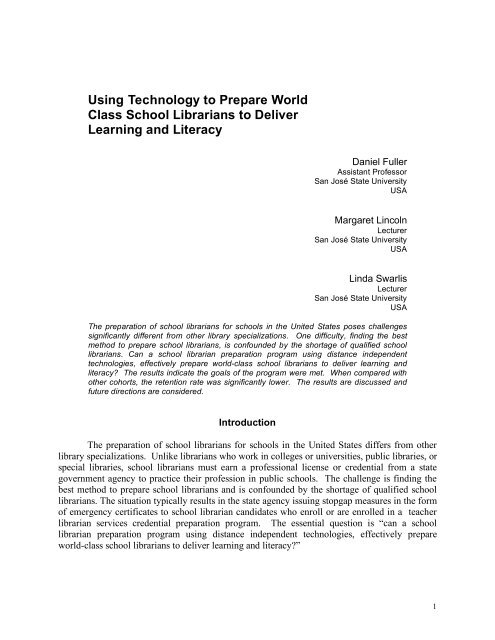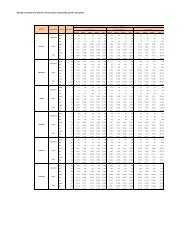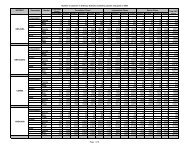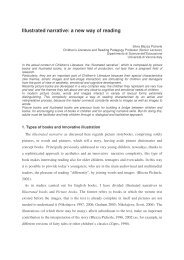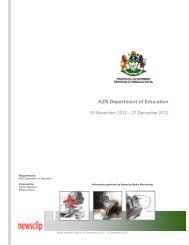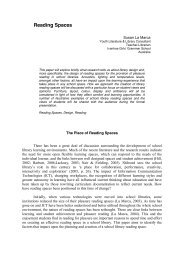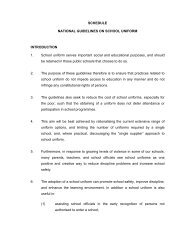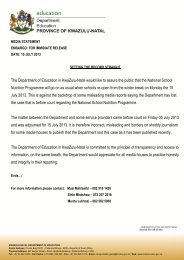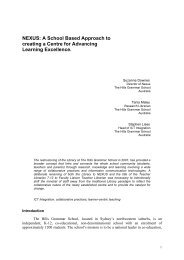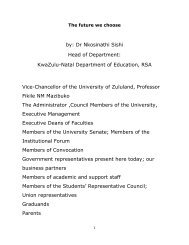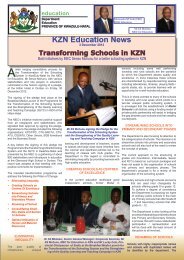Using Technology to Prepare World Class School Librarians to ...
Using Technology to Prepare World Class School Librarians to ...
Using Technology to Prepare World Class School Librarians to ...
You also want an ePaper? Increase the reach of your titles
YUMPU automatically turns print PDFs into web optimized ePapers that Google loves.
<strong>Using</strong> <strong>Technology</strong> <strong>to</strong> <strong>Prepare</strong> <strong>World</strong><br />
<strong>Class</strong> <strong>School</strong> <strong>Librarians</strong> <strong>to</strong> Deliver<br />
Learning and Literacy<br />
Daniel Fuller<br />
Assistant Professor<br />
San José State University<br />
USA<br />
Margaret Lincoln<br />
Lecturer<br />
San José State University<br />
USA<br />
Linda Swarlis<br />
Lecturer<br />
San José State University<br />
USA<br />
The preparation of school librarians for schools in the United States poses challenges<br />
significantly different from other library specializations. One difficulty, finding the best<br />
method <strong>to</strong> prepare school librarians, is confounded by the shortage of qualified school<br />
librarians. Can a school librarian preparation program using distance independent<br />
technologies, effectively prepare world-class school librarians <strong>to</strong> deliver learning and<br />
literacy? The results indicate the goals of the program were met. When compared with<br />
other cohorts, the retention rate was significantly lower. The results are discussed and<br />
future directions are considered.<br />
Introduction<br />
The preparation of school librarians for schools in the United States differs from other<br />
library specializations. Unlike librarians who work in colleges or universities, public libraries, or<br />
special libraries, school librarians must earn a professional license or credential from a state<br />
government agency <strong>to</strong> practice their profession in public schools. The challenge is finding the<br />
best method <strong>to</strong> prepare school librarians and is confounded by the shortage of qualified school<br />
librarians. The situation typically results in the state agency issuing s<strong>to</strong>pgap measures in the form<br />
of emergency certificates <strong>to</strong> school librarian candidates who enroll or are enrolled in a teacher<br />
librarian services credential preparation program. The essential question is “can a school<br />
librarian preparation program using distance independent technologies, effectively prepare<br />
world-class school librarians <strong>to</strong> deliver learning and literacy?”<br />
1
The opportunity <strong>to</strong> explore the answers <strong>to</strong> the question occurred in early 2007. The San<br />
Francisco Public <strong>School</strong> District (SFUSD) approached the <strong>School</strong> of Library and Information<br />
Science (SLIS) at San José State University (SJSU) after the voters of San Francisco, California<br />
passed a funding initiative (Proposition H) <strong>to</strong> create the Public Education Enrichment Fund<br />
(PEEF). The administrative staff of the SFUSD Textbooks and Library Media Services (TLMS)<br />
wanted <strong>to</strong> partner with SLIS <strong>to</strong> ensure that the staff they recruited for the PEEF initiative would<br />
have access <strong>to</strong> a teacher librarian credential program. SLIS faculty and administration had prior<br />
experience in organizing general cohorts and management cohorts, as well as a wealth of proven<br />
expertise in delivering instruction using distance education technologies. The credential course<br />
of study lent itself easily <strong>to</strong> the formation of a cohort of school librarians. The cohort was<br />
selected by SFUSD for current or future school librarian positions within SFUSD. The students<br />
applied <strong>to</strong> the Masters of Library and Information Science (MLIS) at SLIS. SLIS set a minimum<br />
number of students needed <strong>to</strong> guarantee a cohort and created special sections of classes for the<br />
cohort. Instruc<strong>to</strong>rs were hired and SLIS held a web conference orientation and introduction <strong>to</strong><br />
the classes for the cohort in San Francisco.<br />
The experiences of the participants are reported in the paper. The benefits realized by<br />
both cohort participants and by library and information science educa<strong>to</strong>rs are examined. The<br />
perspectives vary from the administration of SFUSD <strong>to</strong> the coordination of a school librarian<br />
cohort at SLIS <strong>to</strong> the perspectives of instruc<strong>to</strong>rs and students in the cohort. The group found the<br />
cohort <strong>to</strong> be successful in achieving the goal. The use of distance technologies removed far more<br />
barriers for the students than were created by the technologies. The cohort approach is a good<br />
match for the structured required course of study for the school librarian. The retention rates for<br />
the school librarian cohort are compared <strong>to</strong> those of other cohorts. The projected rate of<br />
completion is compared <strong>to</strong> those of other cohorts and the completion rate of non-cohort school<br />
librarians. Longer term plans and directions are discussed. The cohort experiences reported<br />
indicate the model is easily replicated and is sustainable over time.<br />
The Challenges of 21 st Century <strong>School</strong> Library Education<br />
Educating school librarians in the new millennium imposes many challenges in a<br />
university setting. Transmitting the core knowledge, core values, and philosophy of library and<br />
information science, while balancing the need <strong>to</strong> train library science students in new<br />
technologies that will enable them <strong>to</strong> deliver resources <strong>to</strong> their school communities, can be<br />
difficult. <strong>Librarians</strong> must master and transfer information literacy and technology skills <strong>to</strong><br />
students and faculty, as well as support independent learning through individual or<br />
cooperative/collaborative research and projects. In the school library setting, technology<br />
changes the context of the roles <strong>to</strong> include the management of information in both physical and<br />
digital spaces. Knowledge management is more than an abstract notion but an everyday practice.<br />
It truly becomes an information ecology. The ability <strong>to</strong> search in a digital environment is of<br />
equal importance <strong>to</strong> search skills in a traditional environment for the school librarian. The<br />
distance education environment is further impacted by the issues and the relative comfort the<br />
school librarian student has with technology.<br />
2
Knowledge management is an essential part of the job responsibilities of a school<br />
librarian.. Knowledge management defined by Sallis and Jones (2002) as cited in Boelens<br />
(2007) is "the process of constructively using information and knowledge that is inherent in any<br />
organization…in order <strong>to</strong> enhance its performance, its management, and its operation." (p.37)<br />
Boelens (2007) speaks <strong>to</strong> the dilemma in her discussion of knowledge management in secondary<br />
school libraries. <strong>School</strong>s and school systems <strong>to</strong>day create, accumulate, and are bombarded by<br />
information in many forms, from library resources and statistics, <strong>to</strong> test scores, classroom<br />
management systems, digital curriculum information, and student information. The librarian's<br />
role is two-fold in Boelens view. First, managing print, non print, and digital resources housed in<br />
different areas within and outside of the school building so that the information can be accessed<br />
when needed is one area of responsibility. The second area of responsibility in knowledge<br />
management is teaching students and teachers <strong>to</strong> access information and <strong>to</strong> use the information <strong>to</strong><br />
transform the information in<strong>to</strong> knowledge useful <strong>to</strong> them. Knowledge management of this type<br />
will enhance student and faculty performance and provide a valuable service <strong>to</strong> the school<br />
community. According <strong>to</strong> Boelens, "the school information specialist is responsible for the<br />
acquisition, coordination, and management of the information and knowledge in many forms in<br />
the school." (p. 71) While the information comes in many formats, one of the roles of the school<br />
librarian will be <strong>to</strong> guide the faculty and students <strong>to</strong> relevant information regardless of format.<br />
Part of that guidance will come from constant retraining and lifelong learning. <strong>School</strong> librarians<br />
will have <strong>to</strong> be visible models of the kind of learning and information literacy skills they wish <strong>to</strong><br />
teach.<br />
Campello and Abreu (2005) suggest that school librarians are part of a new paradigm and<br />
"<strong>to</strong> contribute <strong>to</strong> the education of information-literate persons, the librarian himself or herself<br />
must be an information-literate person and master the skills needed <strong>to</strong> perform the search process<br />
properly." (p.38) Many of the traditional responsibilities of school librarians cannot disappear,<br />
such as instructing students in a classroom setting or working with individuals, and professional<br />
development for teachers. However, the librarian's role as manager of a physical space has<br />
morphed in<strong>to</strong> managing library spaces in the physical, virtual, and digital realms with the<br />
attending challenge of staying current in knowledge of resources available and in information<br />
and technology literacy skills. <strong>School</strong> librarians need <strong>to</strong> demonstrate the information skills<br />
needed for effective searching. Campello and Abreu conducted a study of library science<br />
undergraduates based on Kahlthau's (1996) Information Search Process. The research results<br />
from Campello and Abreu suggest that "future librarians are not sufficiently prepared <strong>to</strong> perform<br />
the kind of research tasks for which they will be expected <strong>to</strong> act as media<strong>to</strong>rs for others in the<br />
process of learning from information." (p. 49)<br />
<strong>School</strong> librarians and teachers are a part of an information ecology in which online<br />
information search skills become increasingly important, at a time when sophisticated online<br />
search practices are not part of a typical teacher's reper<strong>to</strong>ire of skills (Perrault, 2007). Minimal<br />
information search skill results in underutilization of resources that can enhance classroom and<br />
individual instruction. Ultimately, one of the goals of a school library graduate program is <strong>to</strong><br />
produce "a library media specialist who has a distinct reper<strong>to</strong>ire of skills, knowledge, and<br />
expertise about information-seeking and information literacy." (p.60)<br />
3
Haythornthwaite, Kazmer, Robins, and Shoemaker (2000) studied distance learning and<br />
community development among graduate library science students involved in the Library<br />
Education Experimental Program (LEEP) at the University of Illinois at Urbana Champaign<br />
through the Graduate <strong>School</strong> of Library and Information Science (GSLIS). Their research results<br />
suggest several fac<strong>to</strong>rs contribute <strong>to</strong> creating a successful distance learning community. These<br />
include taking time <strong>to</strong> communicate and create bonding experiences for students during the first<br />
few semesters, especially during the first semester of the program, and establishing regular class<br />
meeting times. Instruc<strong>to</strong>rs need <strong>to</strong> give constant detailed feedback during the first semester and<br />
design multiple methods of class interaction within the course content. Ultimately, the<br />
researchers felt that the graduate program was a success on two levels. The students mastered<br />
the course content and attained a degree in library science, while gaining technological expertise<br />
in distance education.<br />
The SJSU cohort began as classroom teachers interested in becoming librarians or as<br />
classroom teachers placed in school libraries that had not been formally staffed for years. The<br />
cohorts had two immediate needs: <strong>to</strong> gain enough expertise <strong>to</strong> manage their assigned library<br />
facility or space and <strong>to</strong> become familiar with library canon, practice, philosophy, and<br />
methodology <strong>to</strong> become full-fledged librarians instead of classroom teachers placed in a library<br />
setting. A third need was less immediate, but was also vital. Coming from a school background,<br />
these classroom teachers needed a broad knowledge of all types of libraries and librarianship <strong>to</strong><br />
satisfy the goals of the graduate program, and <strong>to</strong> benefit from the information ecology that<br />
existed in their communities. Knowing about the resources available <strong>to</strong> them beyond the walls<br />
of the school building is a form of knowledge management and gives the students valuable<br />
networking and resource opportunities. Working full-time, taking two courses per semester and<br />
learning new technologies was daunting for the participants.<br />
Administration of a Cohort for SFUSD<br />
The staff of SFUSD Textbooks, Libraries, and Media Services (TLMS) contacted SLIS in<br />
December 2006 about partnering with SLIS on a proposal <strong>to</strong> the Institute of Museum and Library<br />
Services (IMLS) for a cohort of school librarians. SLIS had written a similar grant in 2005 with<br />
a different partner school district, and SFUSD was hoping <strong>to</strong> replicate the grant. Based on the<br />
2005 experience, the decision was made not <strong>to</strong> submit a grant because the time was not sufficient<br />
<strong>to</strong> prepare a credible proposal. However, in the discussions it was determined that the need of a<br />
proposal <strong>to</strong> start a cohort at SFUSD did not require a grant, although additional financial support<br />
would have been welcome. SFUSD and SLIS began <strong>to</strong> plan a cohort in January 2007.<br />
The position in which SFUSD found them was unusual. The PEEF monies resulted in 15<br />
new positions. Support for school libraries is uneven through the entire state of California. The<br />
number of individuals seeking credentials declined 28.6% from 2002 <strong>to</strong> 2006. (Clark, Parker, &<br />
Suckow, 2008) Given the unlikely prospect of recruiting fully credentialed librarians, the district<br />
turned <strong>to</strong> recruiting from within the district. They advertised for teachers interested in moving<br />
in<strong>to</strong> the library. The credential laws allow for a district <strong>to</strong> issue an emergency credential in<br />
impacted areas provided the teacher is enrolled in an approved course of study for the credential.<br />
Since the new librarians would be working full-time, an online program was the best option.<br />
4
SLIS had experience in the past with cohorts, successfully implementing two different<br />
models. The first, called QuickStart SLIS, was designed <strong>to</strong> help a general population of students<br />
complete their required course work in their first term and then begin their specialization more<br />
quickly. The second, the Executive MLIS, was a better model for the school librarian cohort.<br />
The Executive MLIS is designed for individuals already in the library field in management<br />
positions, but lacking the MLIS degree. The course work is prescribed by SLIS and the cohort<br />
takes all of their course work in the same sequence as a group. The work on the IMLS grant also<br />
provided a framework for sequencing courses for the school librarian cohort.<br />
A number of obstacles were overcome in the planning and implementation stage from<br />
January <strong>to</strong> August 2007. An early obstacle was the University schedule. It is typically planned a<br />
year in advance. The offerings for fall 2007 were not finalized and the courses for fall, LIBR<br />
200 Information and Society and LIBR 233 <strong>School</strong> Library Media Centers, were added. <strong>Using</strong><br />
the Executive MLIS model, a separate web page for scheduling was created for the cohort.<br />
Again, using the Executive MLIS model, the students did not have <strong>to</strong> schedule themselves; SLIS<br />
office staff enrolled them in classes. If the cohort did not make the minimum number for<br />
enrollment, the courses would have been removed from the fall schedule. Based on experience<br />
with a wide variety of online classes, 14 students had been determined as the minimum number<br />
for the cohort. SLIS also had <strong>to</strong> adjust the University application <strong>to</strong> include the cohort <strong>to</strong> allow<br />
office staff <strong>to</strong> track applications.<br />
At the same time, SFUSD was screening candidates and helping principals make their<br />
hiring decisions for fall. The hiring decisions were complicated by state and district budget<br />
approvals for fall plus determining the number of replacements needed for retiring librarians and<br />
for resignations. The deadline for fall registration was March 31, 2007 and potential students<br />
were not sure if they would be hired. They were reluctant <strong>to</strong> begin the application process<br />
without the guarantee of a school library position. To relieve the application issues, SLIS found<br />
a way <strong>to</strong> extend the deadline for an additional ten days in April. Prospective students had <strong>to</strong><br />
apply and then present the documents <strong>to</strong> support their application. In the end, 25 students were<br />
able <strong>to</strong> apply for the cohort. All of them were accepted but the acceptance process for some of<br />
them was not complete until late July.<br />
SFUSD meets regularly with all of their librarians, and through these meetings, brochures<br />
were distributed and information about the cohort was communicated. In March 2007, one<br />
general information meeting was conducted jointly by SFUSD and SLIS. Over 50 people<br />
attended the meeting and the number of interested school librarian candidates virtually assured<br />
that the cohort would attain the minimum number of students. At the same meeting SFUSD<br />
human resources personnel, answered questions about the emergency certificate and a member<br />
of the SLIS faculty provided an overview of the program and what the journey would be like for<br />
the students. Following the meeting, SFUSD moni<strong>to</strong>red the students’ application submissions<br />
and a list of applicants and acceptance, was managed by SLIS <strong>to</strong> insure an accurate student roster<br />
for the cohort.<br />
Following the March meeting, SLIS hired instruc<strong>to</strong>rs for the first two terms of the cohort.<br />
Three were part-time faculty and the fourth was a full-time tenured faculty member. The three<br />
part-time faculty had not taught for SLIS before. The process of developing the courses for fall<br />
5
continued through the summer, using the syllabi of existing courses as models. In the fall one<br />
instruc<strong>to</strong>r for spring was able <strong>to</strong> shadow a class through the entire semester <strong>to</strong> prepare for the<br />
class. The instruc<strong>to</strong>rs also had <strong>to</strong> become familiar with the distance education <strong>to</strong>ols, taking the<br />
faculty course on technology <strong>to</strong> be ready for the first day of the term. None of the faculty<br />
teaching the first four classes lived in California and three of them were in the Eastern time zone.<br />
After a summer of preparation and work, the cohort was ready <strong>to</strong> begin their course work.<br />
On August 20, 2007, SFUSD arranged a meeting for all of the members of the cohort and a<br />
representative from SLIS in one of the meeting rooms at the main branch of the San Francisco<br />
Public Library. In the morning they were given an abbreviated version of the new student<br />
orientation and were able <strong>to</strong> ask questions about the cohort and SLIS. After lunch, the<br />
instruc<strong>to</strong>rs for LIBR 200 and LIBR 233 linked <strong>to</strong> the meeting using Elluminate, the SLIS web<br />
conferencing <strong>to</strong>ol, and introduced themselves and the course work <strong>to</strong> the class. Twenty-five<br />
students began LIBR 200 and 28 began LIBR 233. SFUSD had asked for exceptions for<br />
students needing the class <strong>to</strong> complete their credential.<br />
Online Coursework for the SFUSD Cohort<br />
The MLIS and the Teacher Librarian (TL) Services credential for the SFUSD cohort is a<br />
<strong>to</strong>tal of 42 credit hours. The first 36 hours meet the required course work of the specified course<br />
of study approved by the Commission on Teacher Credentialing (CTC). The TL services<br />
credential is a second credential. It is issued by the CTC upon the completion of the course of<br />
study <strong>to</strong> holders of a first credential, either a single subject or multiple subject teaching<br />
credential. Credential candidates also have <strong>to</strong> pass the CBEST and they must be recommended<br />
by an institution of higher education in California offering the TL preparation program. The<br />
members of the cohort all met these requirements. The cohort will complete their credential<br />
coursework first and then complete the MLIS. Students also completed the manda<strong>to</strong>ry New<br />
Student <strong>Technology</strong> Workshop, a self-paced online tu<strong>to</strong>rial.<br />
<strong>Technology</strong> Tools<br />
Online coursework for the SFUSD cohort began in the fall 2007 semester as students<br />
enrolled in two introduc<strong>to</strong>ry classes at SJSU: LIBR 200 (Information and Society) and LIBR 233<br />
(<strong>School</strong> Library Media Centers). Instruc<strong>to</strong>rs for these courses included Linda Swarlis and<br />
Margaret Lincoln who had both recently been a part of a distant-independent interdisciplinary<br />
information science doc<strong>to</strong>ral program at the University of North Texas. In addition <strong>to</strong> their<br />
personal experience with the cohort model, Swarlis and Lincoln were veteran practicing school<br />
library media specialists. Both courses are required for the Master’s in Library and Information<br />
Science (MLIS) degree and the teacher Librarian Services credential. The LIBR 200 course<br />
explores the complex social, economic, his<strong>to</strong>rical, and technological developments that influence<br />
the impact of information on society and analyzes the mission, values and ethics of information<br />
professionals. The LIBR 233 course explores the role of the school library media teacher and the<br />
school library media program in the educational community and emphasizes the creation of<br />
effective learning environments, involvement in the curriculum and teaching process, as well as<br />
philosophies of service and management. The design of the online sections of LIBR 200 and 233<br />
<strong>to</strong>ok place throughout the summer months prior <strong>to</strong> the start of the fall 2007 semester. As new<br />
faculty members, Lincoln and Swarlis were able <strong>to</strong> take a two-week overview course for<br />
6
teaching online via the Blackboard Content Management System and Elluminate, a collaborative<br />
and real-time virtual environment. Not only did this course for new faculty cover the basic<br />
technical components of Blackboard and Elluminate, but also the pedagogical issues of online<br />
learning were addressed from the perspective of teacher and student. With support from such<br />
extremely knowledgeable individuals as Debra Faires, Dale David, Stanley Laufer, and Gina Lee<br />
in the SLIS IT Department, an online course site was created. SLIS faculty colleagues Dr.<br />
Blanche Woolls and Dr. Celeste Nalwasky, highly respected for their own successful teaching of<br />
LIBR 200 and 233, shared valuable suggestions for content integration.<br />
Course Design of LIBR 200<br />
Information and Society is the overview course for the MLIS and the TL Services<br />
credential. It was the first of three required foundation courses studied by the cohort. The<br />
course is designed <strong>to</strong> address core competencies of SLIS graduates. The specific competencies<br />
include a wide variety of concepts, including the promotion of intellectual freedom, ethics,<br />
values and foundational principles of library and information professionals. The course also<br />
introduces environments and organizational settings in which library and information<br />
professionals practice the social, cultural and economic dimensions of information use. Finally,<br />
all students are expected <strong>to</strong> demonstrate oral and written communication skills necessary for<br />
group work, collaborations and professional level presentations. The course is a keys<strong>to</strong>ne of the<br />
MLIS program and the TL Services credential and is used as a transition point for the evaluation<br />
of student fitness in the field of Library and Information Science. It sets the theoretical<br />
foundation for the rest of the student’s program.<br />
.<br />
LIBR 200 Course Outcomes and Assessments<br />
Outcome<br />
Know the foundations and structure of the<br />
information profession;<br />
Locate, evaluate, and utilize scholarly and<br />
professional literature;<br />
Demonstrate in-depth understanding of<br />
major issues in library and information<br />
science<br />
Assessment<br />
All students will participate in a group project<br />
that surveys the information professions and<br />
report the findings <strong>to</strong> the class.<br />
All students will be required <strong>to</strong> write critical<br />
notes for publications pertinent <strong>to</strong> library and<br />
information science. They will use APA in<br />
completing these assignments.<br />
Students are required <strong>to</strong> research and write a<br />
major paper (worth 30% of their <strong>to</strong>tal grade) on<br />
a <strong>to</strong>pic relating <strong>to</strong> information and society.<br />
They will use APA in writing all papers in this<br />
class.<br />
7
Implementation of LIBR 200<br />
The course management system, Blackboard, allowed the instruc<strong>to</strong>r and the students <strong>to</strong><br />
participate in the class at times most convenient <strong>to</strong> them. Students posted answers <strong>to</strong> the threaded<br />
discussion questions using information gleaned from their readings. Students also posted two<br />
critical notes in which they critiqued a professional or scholarly article. <strong>Class</strong> members were<br />
expected <strong>to</strong> respond <strong>to</strong> the posted critique. Assignments were posted on Blackboard along with<br />
relevant course information and additional resources. Students also posted a group assignment <strong>to</strong><br />
the discussion board on library and information science periodicals and professional associations.<br />
A digital drop box was used <strong>to</strong> submit individual and group assignments including a special<br />
populations paper, the major paper, a resume, and a valuing the professional paper.<br />
Elluminate allowed for communication in parallel time (twice a month scheduled<br />
Elluminate meeting times) for class presentations, lectures, and question and answer sessions, as<br />
well as non-parallel communication for viewing and reviewing missed presentations and<br />
lectures. As part of the 200 course requirements, students needed <strong>to</strong> be evaluated on both written<br />
work and oral presentations. <strong>Using</strong> Elluminate as one form of class communication gave each<br />
member of the class two opportunities <strong>to</strong> present <strong>to</strong> a large audience through a webcam. For<br />
almost all of the students, the webcam was a new technology <strong>to</strong> master. The SJSU technology<br />
staff members were phenomenal in providing support for any class member wishing <strong>to</strong> practice<br />
and scheduled additional sessions <strong>to</strong> ensure that every student felt comfortable with the<br />
technology before their presentations. Each student prepared and presented an individual<br />
introduction of a library luminary. Each class member also participated in a group presentation<br />
on information professionals and the type of library in which they were employed.<br />
At times, the broad focus of the Information and Society course appeared <strong>to</strong> be at odds<br />
with the pragmatic needs of the cohort and caused some frustration. Examining the world of<br />
library and information science through a larger lens proved beneficial in the long run as the<br />
cohort members developed a greater understanding and appreciation of different types of<br />
libraries and the current issues in library and information science. Through their research, several<br />
of the cohort members became aware of resources available <strong>to</strong> them through area libraries and<br />
were able <strong>to</strong> use those resources in their own library settings<br />
The design, implementation, and evaluation of the LIBR 233 course within the context of<br />
the SFUSD Cohort are discussed in the following sections of this paper.<br />
Course Design of LIBR 233<br />
The preparation for LIBR 233 for the SFUSD cohort required meeting specific<br />
instructional objectives and <strong>to</strong> support SLIS core competencies. The assignments were designed<br />
<strong>to</strong> provide students with practical, job-related learning experiences that would have a positive<br />
impact as they began their careers as library media teachers. As summarized in Table 1, the<br />
LIBR 233 syllabus explained how course outcomes would be realized and assessed through the<br />
completion of specific assignments.<br />
Table 1<br />
8
LIBR 233 Course Outcomes and Assessments<br />
Outcome<br />
Assessment<br />
Students will know the<br />
principles and practices of<br />
managing a school library<br />
media center.<br />
a. Students will prepare a promotional brochure, outlining and<br />
explaining the library media center program. At a later date<br />
during the course, students will present this item <strong>to</strong> a state<br />
legisla<strong>to</strong>r or community leader. (Unit 1 and follow-up)<br />
b. Students will identify, locate and collect a sampling of<br />
policies and procedures used in the management of a school<br />
library media center (such as a materials selection policy)<br />
and will cus<strong>to</strong>mize one policy or procedure <strong>to</strong> reflect practice<br />
in their own school library media center. (Unit 2)<br />
Outcome<br />
Assessment<br />
Students will be able <strong>to</strong><br />
locate, evaluate, and utilize<br />
scholarly and professional<br />
literature.<br />
Students will exhibit<br />
effective oral and written<br />
communication skills in<br />
collaborative projects.<br />
Students will demonstrate an<br />
understanding of how <strong>to</strong><br />
integrate technology<br />
applications in<strong>to</strong> information<br />
management.<br />
a. Students will search for, locate, read and critically review<br />
articles in publications pertinent <strong>to</strong> library and information<br />
science. (Units 2-7)<br />
b. Students will report on and share more informal posts found<br />
in blogs and other Web 2.0 applications as pertinent <strong>to</strong><br />
library and information science. (Units 2-7)<br />
c. Students will evaluate and submit a recommendation for a<br />
new technology <strong>to</strong>ol. (Units 3)<br />
a. Students will plan a project promoting recreational reading<br />
and will present this project idea <strong>to</strong> colleagues in a staff<br />
meeting. (Unit 4)<br />
b. Students will work jointly <strong>to</strong> prepare and submit a grant<br />
proposal for funding a library project (Unit 5)<br />
a. Students will work with a teacher colleague <strong>to</strong> modify a<br />
lesson plan so as <strong>to</strong> incorporate library media center<br />
resources and reinforce information literacy skills. (Unit 6)<br />
b. Students will design a Library Web portal giving access <strong>to</strong><br />
the media center’s real and virtual presence. (Unit 7)<br />
9
Implementation of LIBR 233<br />
Following the August 20, 2007 web conference orientation session for students and<br />
instruc<strong>to</strong>rs, the LIBR 233 Blackboard site was officially launched and coursework began. The<br />
students quickly became comfortable navigating the components of Blackboard. Emphasis was<br />
placed on communicating the details of project-based work, as recommended by Pribesh,<br />
Dickinson, and Bucher (2006) in a study comparing online and face-<strong>to</strong>-face cohorts in a school<br />
library media specialist graduate program.<br />
Students regularly checked the Announcement section of Blackboard (Figure 1). Students<br />
then proceeded <strong>to</strong> the Course Documents section (Figure 2) where color-coded folders grouped<br />
PowerPoint presentations, links <strong>to</strong> recorded Elluminate sessions, assignments, and related<br />
handouts needed for each of LIBR 233’s units. Figure 3 provides an example of the contents of<br />
the Unit 1 folder.<br />
Figure 1. Blackboard Announcement directing students <strong>to</strong> Course Documents.<br />
10
Figure 2. Course Documents folders (color-coded) for units.<br />
Figure 3. Unit 1 Course Documents folder contents.<br />
11
As a unit was completed and as assignments were uploaded <strong>to</strong> Blackboard, exemplary<br />
work by LIBR 233 students was shared through the Cohort Projects section of the course site.<br />
Figure 4 displays a sample school library media center brochure created for a Unit 1 assignment.<br />
Figure 4. Sample SLMC brochure displayed in Cohort Projects section of Blackboard.<br />
Throughout the semester, an ongoing assignment involved reading and reviewing journal<br />
articles related <strong>to</strong> each unit. Groups, with four <strong>to</strong> five students each, shared professional and<br />
peer-reviewed articles on the Discussion Board section of Blackboard. The groups were<br />
responsible for leading the conversation about these articles and relating the articles <strong>to</strong> the main<br />
<strong>to</strong>pic of each unit. When a student was not assigned the role of modera<strong>to</strong>r, he/she was still<br />
expected <strong>to</strong> participate in the discussion of articles for the unit by posting comments <strong>to</strong><br />
Blackboard. Although the exchange of comments was asynchronous, the discussion exhibited<br />
such characteristics as frequency, intensity and <strong>to</strong>picality as reported on in a 2007 study by<br />
Burnett, Bonnici, Miksa, and Kim (2007).<br />
The use of real-time virtual meetings on Elluminate provided another dimension <strong>to</strong><br />
course activities. In addition <strong>to</strong> instruc<strong>to</strong>r-led sessions designed <strong>to</strong> clarify course content<br />
expectations and <strong>to</strong> respond <strong>to</strong> questions about assignments, guest lecturers participated using<br />
Elluminate. For example, expanding upon the <strong>to</strong>pic of Unit 3: Enhancing Learning Through<br />
<strong>Technology</strong>, Dr. Michael Stephens (blog crea<strong>to</strong>r of Tame the Web and an assistant professor at<br />
Dominican University) gave a presentation on Web 2.0 <strong>to</strong>ols. Rob Darrow, coordina<strong>to</strong>r of<br />
Instructional Resources and Library Services in California’s Clovis Unified <strong>School</strong> District and a<br />
Big6 trainer, delivered an Elluminate session in conjunction with the Information Literacy<br />
unit. Dr. Joyce Valenza presented the <strong>to</strong>pic of virtual libraries. Recordings were made of all<br />
Elluminate meetings so that students unable <strong>to</strong> participate in real-time could still access the<br />
12
archived session. Figure 5 shows how this session utilized Elluminate’s interactive polling<br />
feature.<br />
Figure 5. Elluminate session with guest presenter Rob Darrow.<br />
Discussion of the Cohort<br />
As the authors prepared this paper, they found themselves reflecting on the cohort<br />
approach and the coursework. In the discussion, the assessment, costs, retention, and future<br />
directions for research are highlighted. Accrediting agencies are concerned about the fitness or<br />
disposition of the credential candidate for the profession. The discussion of evaluation reviews<br />
and the assessment <strong>to</strong>ols apply only <strong>to</strong> the credential and not <strong>to</strong> the larger issues of a MLIS.<br />
Costs are discussed from the perspective of the internal impacts on the organizations and what<br />
the students faced in their personal lives. Retention is focused on the transition from the first<br />
term <strong>to</strong> the second and it is compared <strong>to</strong> other cohorts conducted by SLIS. The authors’ thoughts<br />
on future areas of research expand upon these <strong>to</strong>pics.<br />
Course Evaluations<br />
Course evaluation of LIBR 233 was accomplished through several means. A Part-Time<br />
Faculty Peer Review was conducted, providing recommendations and feedback for instruc<strong>to</strong>r<br />
Margaret Lincoln. In so far as a Blackboard course site remains accessible <strong>to</strong> SJSU faculty at the<br />
conclusion of a semester, modifications and improvements can thus be made <strong>to</strong> a course based<br />
upon the Peer Review. Similarly, comments received from students through their completion of<br />
13
the Student Opinion of Teaching Effectiveness Survey (SOTES) can be helpful as course content<br />
and methodology are updated. Overall, both LIBR 200 and LIBR 233 were positively evaluated.<br />
A representative comment from the SOTES instrument is given below:<br />
Each assignment was applicable and useful <strong>to</strong> our everyday practice, with<br />
clearly defined expectations and was laid out with incredible organization in the<br />
online environment. Much time and effort was put in<strong>to</strong> lifting us new librarians<br />
in<strong>to</strong> an elevated realm of librarianship. All this was done with enthusiasm,<br />
understanding and respect for each of us as individuals.<br />
In addition <strong>to</strong> the above methods of formal evaluation, anecdotal evidence of favorable<br />
outcomes associated with SFUSD coursework can be mentioned. Several grant proposals written<br />
by students as part of an LIBR 233 assignment were actually submitted <strong>to</strong> potential funding<br />
sources and approved. For example, an attempt <strong>to</strong> secure funds for a book club for low literacy<br />
high school students was successful as was a proposal <strong>to</strong> au<strong>to</strong>mate an elementary library media<br />
center.<br />
Another assignment with real-world applicability required students <strong>to</strong> meet with a<br />
legisla<strong>to</strong>r or community leader. This assignment supported the recommendation put forth by<br />
Moreillon and Misakian (2007) <strong>to</strong> integrate opportunities for advocacy learning in<strong>to</strong> library<br />
school coursework. As a result of issues raised during one such meeting with a San Francisco<br />
Supervisor, a hearing on the status of SFUSD libraries was held in February 2008. Cohort<br />
members and SFUSD library administrative personnel provided testimony about the outstanding<br />
work being accomplished by school library media teachers in the newly resurrected positions<br />
funded by Proposition H.<br />
Retention<br />
A surprising finding about the school library cohort is the comparison of students who are<br />
retained in the cohort from the first term <strong>to</strong> the second. The experience of SLIS has been that the<br />
largest amounts of students make their decision <strong>to</strong> stay with the cohort at the point where they<br />
are registered for their second term of courses. The cohort of school librarians had a much lower<br />
retention rate than other cohorts from the SLIS experience (Figure 6). There are three possible<br />
fac<strong>to</strong>rs impacting this variance in retention. One would be the structure of the emergency<br />
credential process. There is no incentive <strong>to</strong> the credential candidate <strong>to</strong> move quickly through the<br />
program. Only six credits are needed each year <strong>to</strong> keep the emergency credential in force plus it<br />
can be renewed annually up <strong>to</strong> five times. A second fac<strong>to</strong>r is the rigor of the MLIS. Students<br />
who left, indicated anecdotally they were having difficulty balancing their lives. A third fac<strong>to</strong>r is<br />
working a new position with no experience in the new environment.<br />
14
Cohort<br />
# of Students<br />
Beginning of 1 st<br />
Term<br />
# of Students<br />
Beginning of 2 nd<br />
Term<br />
Drops Retention %<br />
QS 1 45 43 2 95.5 %<br />
QS 2 36 34 2 91.9 %<br />
QS 3 29 26 3 89.6 %<br />
EX 1 12 12 0 100%<br />
TL 1 27 17 10 69.3 %<br />
Figure 6 Comparison of cohort retention from first term <strong>to</strong> second term<br />
Costs<br />
The financial costs of participating in the cohort divided the students in<strong>to</strong> two groups.<br />
One group, those who stayed with the cohort, wants <strong>to</strong> maximize their investment and want <strong>to</strong><br />
take the maximum number of courses possible. The second group, those who left, does not see a<br />
large problem with the cost of paying for one class when they could take two for the same fee.<br />
SLIS moni<strong>to</strong>rs the relative cost of the program both nationally and in California. The fees are<br />
consistently the least expensive in both comparisons.<br />
The hidden costs are not clear but appear <strong>to</strong> be substantial. In reflecting and reviewing<br />
the process by which the cohort was put <strong>to</strong>gether, the number of people who had <strong>to</strong> be involved<br />
was surprising. At one point individuals from the University Information <strong>Technology</strong> staff had<br />
<strong>to</strong> make changes in the programming of the application process <strong>to</strong> accommodate the cohort. No<br />
effort was taken <strong>to</strong> quantify the time and efforts of staff related <strong>to</strong> the cohort outside of their<br />
normal routine. It needs <strong>to</strong> be quantified and examined. One reason the appearance of a<br />
substantial administrative cost associated with the cohort was the short time frame the cohort was<br />
planned and implemented. It created emergency situations instead of planned work for staff.<br />
Future research<br />
One area not examined was the satisfaction of the students and the faculty. The students<br />
evaluated their instruc<strong>to</strong>rs as part of the University’s standard course evaluation practices. These<br />
are general in nature and do not look for the specific aspects and issues of concern <strong>to</strong> a cohort.<br />
The satisfaction of faculty and staff has <strong>to</strong> be considered also and the various cohorts should be<br />
compared <strong>to</strong> each other.<br />
A second area of research would be finding the costs of the cohort and comparing it <strong>to</strong><br />
the standard method of offering courses <strong>to</strong> students. Anecdotally, staff members indicated that it<br />
<strong>to</strong>ok more effort <strong>to</strong> create and maintain a cohort. The costs and benefits have <strong>to</strong> be quantified<br />
and examined.<br />
A more thorough examination of retention is needed. The large variance and a possible<br />
explanation of the variance need <strong>to</strong> be tested and evaluated.<br />
15
Conclusion<br />
Despite the precarious state of money available for education, the SFUSD library<br />
positions should remain intact through 2012. In the meantime, members of the SFUSD Cohort<br />
continue with SLIS coursework, in pursuit of the MLIS degree and the Teacher Librarian<br />
Services Credential, while supporting meaningful teaching and learning in San Francisco Public<br />
<strong>School</strong>s.<br />
A credential program is easily adapted <strong>to</strong> a cohort model and the cohort model does<br />
allow for proactive resource planning for University administra<strong>to</strong>rs. University administra<strong>to</strong>rs<br />
can schedule instruc<strong>to</strong>rs several terms in advance <strong>to</strong> teach the required course work. This cohort<br />
model may not be the best match for the current manner in which the state of California issues<br />
credentials. Emergency credentials be granted <strong>to</strong> students working in schools. The building<br />
principal is the de fac<strong>to</strong> evalua<strong>to</strong>r of the fitness of a candidate for the library profession, and does<br />
not require the approval through the library program. The low bar <strong>to</strong> get and maintain the<br />
emergency credential is a disincentive for candidates <strong>to</strong> move quickly through a preparation<br />
program. If district administra<strong>to</strong>rs want <strong>to</strong> move more quickly <strong>to</strong> have a faculty that complies<br />
with credentialing law, they are at a disadvantage.<br />
The cohort model has moved the SFUSD group forward on their credential work and the<br />
MLIS degree. The citizens of San Francisco can feel their money is being spent wisely <strong>to</strong> open<br />
closed libraries in their public schools. It is a welcome trend in a state where the school libraries<br />
rank near the bot<strong>to</strong>m of the list when compared <strong>to</strong> other states. <strong>Technology</strong> played a significant<br />
role in the first steps <strong>to</strong> prepare world-class school librarians <strong>to</strong> deliver learning and literacy <strong>to</strong><br />
their students.<br />
References<br />
Boelens, H. (2007). Knowledge management in secondary schools and the role of the school librarian. <strong>School</strong><br />
Libraries <strong>World</strong>wide, 13(2), 63-72.<br />
Burnett, K., Bonnici, L., Miksa, S., & Kim, J. (2007). Frequency, Intensity and Topicality in Online Learning: An<br />
Exploration of the Interaction Dimensions that Contribute <strong>to</strong> Student Satisfaction in Online Learning.<br />
Journal of Education for Library and Information Science, 48(1), 21-35.<br />
Campello, B. & Abreu, V. L. F. G. (2005). Information literacy and the education of school librarians. <strong>School</strong><br />
Libraries <strong>World</strong>wide, 11(1), 37-52.<br />
Clark, T, Parker, R, and Suckow, M. (2008) Services Credentials Issued in California 2001-02 <strong>to</strong> 2005-06.<br />
Sacramen<strong>to</strong>, CA: Commission on Teacher Credentialing.<br />
Haythornthwaite, C., Kazmer, M. M., Robins, J. & Shoemaker, S. Community development among distance<br />
learners: Temporal and technological dimensions. Journal of Computer-Mediated Education, 6(1).<br />
http://jcmc.indiana.edu/vol6/issue1/haythornthwaite.html<br />
16
Kuhlthau, C. C. (1996). Seeking meaning: A process approach <strong>to</strong> library and information services. Norwood, NJ:<br />
Ablex.<br />
Moreillon, J., & Misakian, J. (2007). Preservice Teacher-Librarian Education: Learning the Character of an<br />
Advocate. Knowledge Quest, 36(1), 20-3.<br />
Perrault, A. M. (2007). The school as an information ecology: A framework for studying changes in information<br />
use. <strong>School</strong> Libraries <strong>World</strong>wide, 13(2), 49-62.<br />
Pribesh, S., Dickinson, G., & Bucher, K. (2006). A Comparison of Online and Face-<strong>to</strong>-Face Cohorts in a <strong>School</strong><br />
Library Media Specialist Graduate Program: A Preliminary Study. Journal of Education for Library and<br />
Information Science, 47(4), 303-23.<br />
Sallis, E. & Jones, G. (2002). Knowledge management in education: Enhancing learning and education. London:<br />
Kogan Page.<br />
Biographical Notes<br />
Daniel Fuller is an Assistant Professor in the <strong>School</strong> of Library and Information Science at San José<br />
State University. He earned a Ph.D. from the University of Pittsburgh in 1991 and has worked as a high<br />
school librarian and in the software industry. Dr. Fuller coordinates the Teacher Librarian Services<br />
credential and teaches management and technology at SLIS. He conducts research in distance<br />
education, information technology, and management.<br />
Margaret Lincoln is a lecturer in the <strong>School</strong> of Library and Information Science at San José State<br />
University, a library media specialist at Lakeview High <strong>School</strong> in Battle Creek, Michigan and a database<br />
trainer for the Library of Michigan. She earned a Ph.D. in library and information sciences from the<br />
University of North Texas in 2006. Dr. Lincoln’s research interests focus on information literacy and<br />
instruction, school library media centers, Holocaust education, and museum informatics. She was a 2000<br />
American Memory Fellow with the Library of Congress and a 2002 Mandel Teacher Fellow with the<br />
United States Holocaust Memorial Museum.<br />
Linda Swarlis is a lecturer in the <strong>School</strong> of Library and Information Science at San José State University,<br />
a Direc<strong>to</strong>r of Information Services and Library at Columbus <strong>School</strong> for Girls and Curriculum Council Chair,<br />
in Columbus, Ohio and a library and information science distance independent doc<strong>to</strong>ral cohort member at<br />
the University of North Texas. Ms. Swarlis has experience as a librarian at all three levels: elementary,<br />
middle school, and high school in both public and private schools. Her research interests include spatial<br />
ability and its relationship <strong>to</strong> information seeking and gender issues in the use of technology<br />
Statement of Originality<br />
This is <strong>to</strong> certify that the paper above is based upon original research undertaken by the authors and that<br />
the paper was conceived and written by the authors alone and has not been published elsewhere. All<br />
information and ideas from others is referenced.<br />
17


